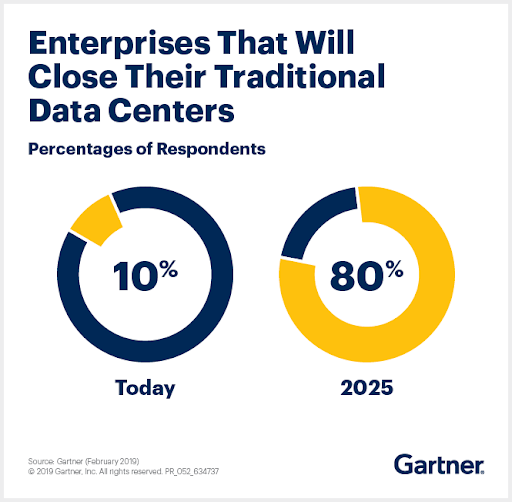The Des Moines metro is committed to creating an environment that…
Life of the Data Center
 In my 20-plus years of working in the data center space, I have seen technology come and go as well as processes changed and security enhanced. I remember the days when manuals were the only way to figure things out, whereas now, we can just google it… Nevertheless, technology has come a long way since 1946, when the Electronic Numerical Integrator and Computer (ENIAC) was built to support the U.S. Army, storing artillery firing codes during World War II. For the next 50+ years, data centers went from large mainframe systems to distributed systems. The next major shift was in 1999, when VMware released their virtual platform for PCs.
In my 20-plus years of working in the data center space, I have seen technology come and go as well as processes changed and security enhanced. I remember the days when manuals were the only way to figure things out, whereas now, we can just google it… Nevertheless, technology has come a long way since 1946, when the Electronic Numerical Integrator and Computer (ENIAC) was built to support the U.S. Army, storing artillery firing codes during World War II. For the next 50+ years, data centers went from large mainframe systems to distributed systems. The next major shift was in 1999, when VMware released their virtual platform for PCs.
In 2001, VMware ESX was born, which ignited a revolution to start virtualizing resources that once had to be on physical servers. This adoption took time, but today VMware is the strongest, most mature virtualization platform available. According to Gartner, the virtualization market is nearly at its peak, with many organizations having server virtualization rates that exceed 75 percent. According to the IDC, VMware owns 80.7 percent of that market as of 2017.
Having this technology has enabled data centers to provide improved high availability, on-demand resource allocation, faster resource provisioning, better visibility, and improved disaster recovery strategies. Even with all these efficiencies, there is still a need to manage physical servers, storage, and network equipment. This means your staff is spending time doing firmware patches, hard drive replacements, lun allocations, and re-wiring of networks in cabinets to support the next new bandwidth, requiring new cabling. This is an investment in both capital every three to five years and staff to upgrade, replace, and continually maintain the environment. So, is being in the data center right for your business?
Data Centers and You
So, you are still asking yourself, “Why do I really want to get out of running my data center or computer room?” Well, the best way to answer this question is to consider what your business does and where managing data centers, physical servers, and firmware fits into your offering. The truth is: it probably doesn’t for most organizations. This means you are performing services that don’t benefit your business, taking staff away from potentially valuable services that can benefit the business and help drive success and revenue growth.
Gartner predicts that by 2025, 80 percent of traditional data centers will be shut down, and as of now, 10 percent already have been. Many organizations struggle to manage their current data center operations, sometimes having to choose to forego patching so business-led initiatives can be done, which adds up over time. This neglect causes a lack of proactive management or maintenance of servers, storage, or network devices, which leads to unexpected outages, longer recovery times, and security holes.
Hosting Provider
Some companies have figured out an alternative model: using a hosting provider, whether unmanaged or managed. The difference between these models is who manages the environment for your business. In unmanaged, it is just as it sounds; you are left to manage the servers, storage, network, and all services. The only things provided for you are security controls and network connectivity to your space. The managed option, for many providers, has different options and levels available, with different costs, service level agreements (SLAs), and recovery models.
Finding the right cost/benefit ratio is key when considering these options. Doing the right level of research on providers is important to ensure you find one with experience in what you need them to manage. I have seen many hosting providers take on services that weren’t their specialty, and the customer ends up having more frequent, longer downtimes due to this.
The hosting provider model is one step in the right direction out of managing your own data center, but due diligence is necessary to make sure the solution is right for your business and availability requirements.
Hyper-converged Infrastructure: A Middle Ground
 A possible middle ground between the current challenges of on-premises data centers and going full public cloud is a hyper-converged infrastructure (HCI). These solutions are generally considered “complete” solutions, providing compute, storage, and network resources to a virtualization platform, also known as server virtualization. Depending on the vendor and solution, this could include an appliance and firmware management, and if available, the vendor may provide all services in a managed services capacity.
A possible middle ground between the current challenges of on-premises data centers and going full public cloud is a hyper-converged infrastructure (HCI). These solutions are generally considered “complete” solutions, providing compute, storage, and network resources to a virtualization platform, also known as server virtualization. Depending on the vendor and solution, this could include an appliance and firmware management, and if available, the vendor may provide all services in a managed services capacity.
The leader in the HCI space is Nutanix, which offers a variety of models. They allow you to repurpose your existing compute and storage resources and put a layer over them and provide you options for your virtualization layer, whether you use their native Acropolis (AOS) platform, VMware, Microsoft Hyper-V, or Citrix. This still requires an on-premises model, but it greatly reduces the day-to-day management if implemented correctly. It may or may not be the right solution to a big portion of your workload needs and should be considered with your cloud strategy.
Why Not Use Public Cloud?
 With the growth of cloud since AWS first launched publicly in 2006, cloud has gone from concept to buzzword to reality. With multiple options regarding private, public, and hybrid cloud solutions, building the right model to make the most of your IT services is available — with the right level of strategic planning.
With the growth of cloud since AWS first launched publicly in 2006, cloud has gone from concept to buzzword to reality. With multiple options regarding private, public, and hybrid cloud solutions, building the right model to make the most of your IT services is available — with the right level of strategic planning.
However, there are still a number of skeptics out there who feel moving to public cloud is too risky, with concerns around data security within a shared public cloud storage system or connectivity performance for end-users who are on-premises. Over the years, the top cloud providers like AWS and Microsoft have invested a considerable amount of money on security enhancements, ensuring compliance is met and the best level of security is available to their customers. They have invested more time and money than most companies spend on their entire IT budget.
Connectivity enhancements have come a long way, with different options to have high-bandwidth solutions or edge solutions (puts the service closest to the user). If not done right, clouds can be overwhelming, and costs can get out of hand. But when done correctly, the benefits are huge for your business, enabling IT staff to be more strategic, more focused on ways to help the business grow, and less consumed by day-to-day operations and maintenance tasks. Time can be spent on automation, auto-provisioning, enhanced security monitoring, and DevOps, to name a few. Having the cloud tooling at your fingertips provides a number of resources that were unavailable or difficult to implement previously.
Not Sold?
So, are you still hung up? Are you still thinking moving to the cloud is too risky? Are you still thinking you can ensure your data is more secure within your data center? Maybe looking back on the past failures of large organizations like Yahoo, when 3 billion accounts were hacked in 2013, or Marriott, who had 500 million guests with unauthorized access from 2014 to 2018, will make you reconsider. (And there are a number of other examples, too, but we’ll save that for another day.)
It is hard to say exactly how their hosting model attributed to their failure, but the more tools and solutions available to enhance your security, the better prepared you are for hacks like these. No one thinks it will happen to them, but either someone will try — and succeed — or you have the right tools to enable quick discovery of cyber attacks to either address them automatically or in a timely fashion to reduce the overall impact to your business and customers.
Time to Strategize
Shutting down the data center isn’t necessarily the right path for everyone, but looking at ways to leverage public, private, or hybrid cloud models needs to be part of your strategy. As mentioned, most organizations aren’t in the IT business, but IT is there to support the business. It is time to shift that focus and enable the business to do the things to grow and succeed and allow IT to be more agile and better prepared to provide the best services possible. If this has hit a nerve or got you wondering more, now is the perfect time to reach out to us and see why a cloud roadmap is the best first step to getting into a better business-driven infrastructure model for your organization.





This Post Has 0 Comments